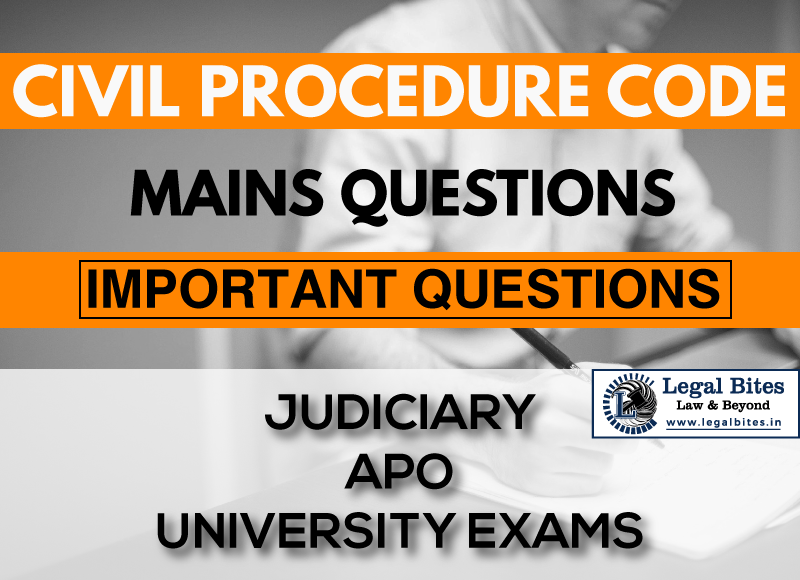What procedure has been prescribed in the Civil Procedure Code for the disposal of a suit in which a substantial question of law as to the interpretation of the Constitution or as to the validity of any statutory instrument is involved?
Order XXVII-A of the Code of Civil Procedure, 1908 refers to the power of the court to deal with Suits Involving a Substantial Question of Law as to the Interpretation of the Constitution or

Question: What procedure has been prescribed in the Civil Procedure Code for the disposal of a suit in which a substantial question of law as to the interpretation of the Constitution or as to the validity of any statutory instrument is involved? [MPHJS 2018] Find answer only on Legal Bites. [What procedure has been prescribed in the Civil Procedure Code for the disposal of a suit in which a substantial question of law as to the interpretation of the Constitution or as to the validity of...
Question: What procedure has been prescribed in the Civil Procedure Code for the disposal of a suit in which a substantial question of law as to the interpretation of the Constitution or as to the validity of any statutory instrument is involved? [MPHJS 2018]
Find answer only on Legal Bites. [What procedure has been prescribed in the Civil Procedure Code for the disposal of a suit in which a substantial question of law as to the interpretation of the Constitution or as to the validity of any statutory instrument is involved?]
Answer
Order XXVII-A of the Code of Civil Procedure, 1908 refers to the power of the court to deal with Suits Involving a Substantial Question of Law as to the Interpretation of the Constitution or as to the Validity of any Statutory Instrument.
The Civil Court has powers under Order XXVII-A of the Code of Civil Procedure, 1908 which are equivalent to Articles 226 and 227 of the Constitution of India. The Civil Court has very vast powers, which cannot be underestimated.
Rule 1 of the order says that in any suit in which it appears to the Court that any such question as is referred to in clause (1) of Article 132, read with Article 147 of the Constitution is involved, the Court shall not proceed to determine that question until after notice has been given to the Attorney General for India if the question of law concerns the Central Government and to the Advocate- General of the State if the question of law concerns a State Government.
Rule 1-A was inserted by the 1976 Amendment Act which provides that when the vires of a statutory instrument are challenged in a suit, the authority issuing the statutory instrument should be made a party to the suit. In State of Gujarat v. KC Shah, AIR 1991 SC 695, where the Supreme Court declared the provision of a State Act ultra vires. The concerned State governments were parties and duly represented before the Court. The binding effect of such a decision cannot be ignored merely because there was some procedural irregularity, like the non-issuing of notice to State Governments.
Rule 2 of Order XXVII-A also provides that the court may at any stage of the proceedings order that the Central Government of a State Government shall be added as a defendant in any suit involving any such question as is referred to in Cl. 1 of Art. 132 read with Art. 147 of the Constitution.
Rule 2A provides for the court power to order the Government or other authority at any stage of the proceedings in any suit be added as a defendant if the Government pleader or the pleader appearing in the case for the authority which issued the instrument, as the case may be, whether upon receipt of notice under rule 1A or otherwise, applies for such addition, and the Court is satisfied that such addition is necessary or desirable for the satisfactory determination of the question.
Rule 2-A was added to ensure that the Government or other authority issuing the statutory instrument is given an opportunity to join as a party in such cases.
Important Mains Questions Series for Judiciary, APO & University Exams
- CPC Mains Questions Series: Important Questions Part – I of X
- CPC Mains Questions Series: Important Questions Part – II of X
- CPC Mains Questions Series: Important Questions Part – III of X
- CPC Mains Questions Series: Important Questions Part – IV of X
- CPC Mains Questions Series: Important Questions Part – V of X
- CPC Mains Questions Series: Important Questions Part – VI of X
- CPC Mains Questions Series: Important Questions Part – VII of X
- CPC Mains Questions Series: Important Questions Part – VIII of X
- CPC Mains Questions Series: Important Questions Part – IX of X
- CPC Mains Questions Series: Important Questions Part – X of X
Admin Legal Bites
Legal Bites Study Materials correspond to what is taught in law schools and what is tested in competitive exams. It pledges to offer a competitive advantage, prepare for tests, and save a lot of money.

